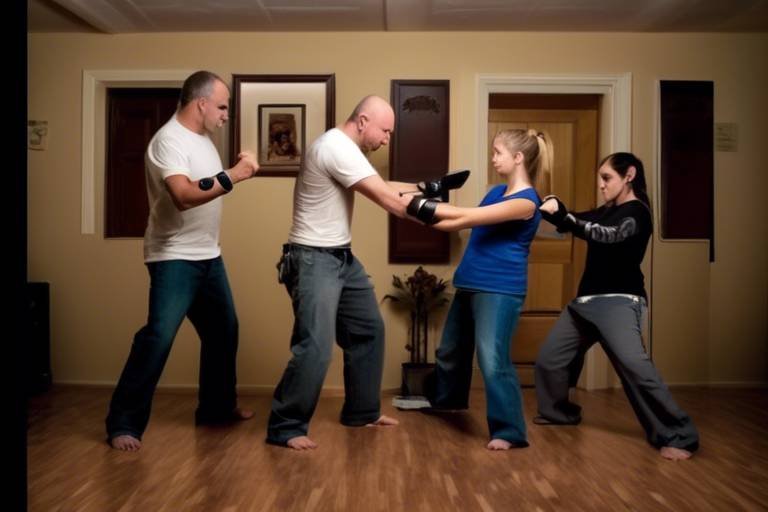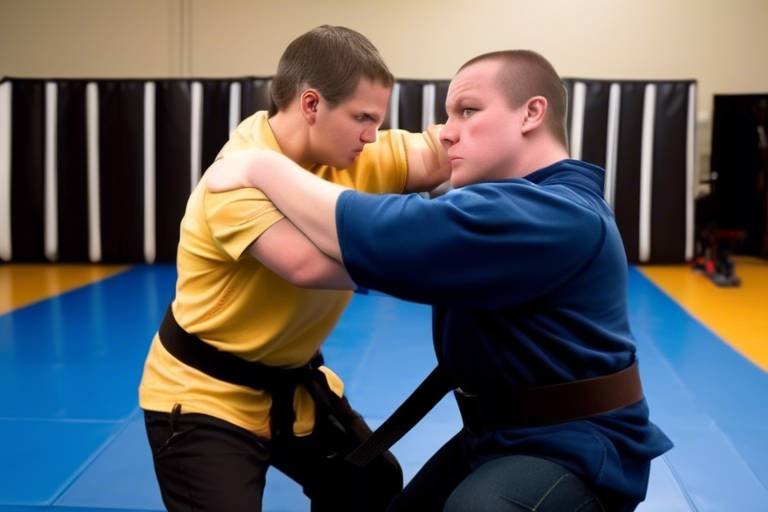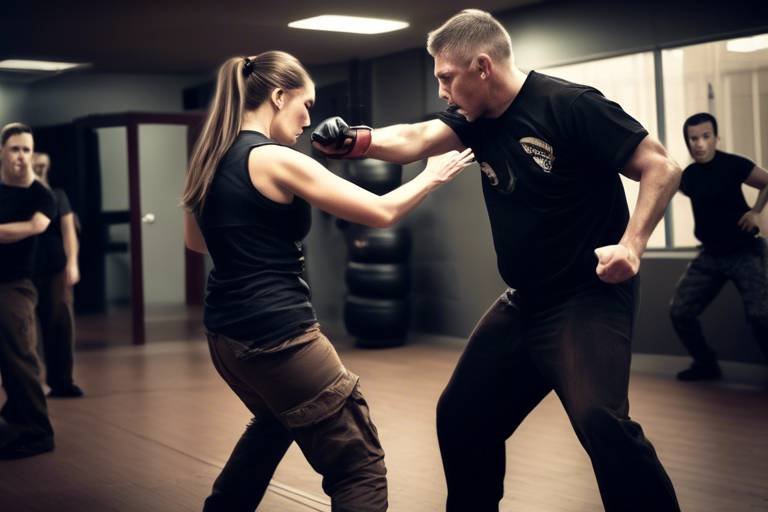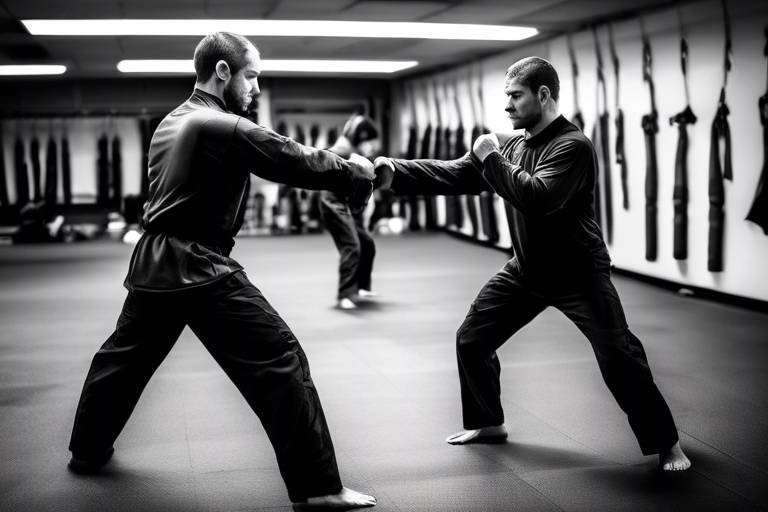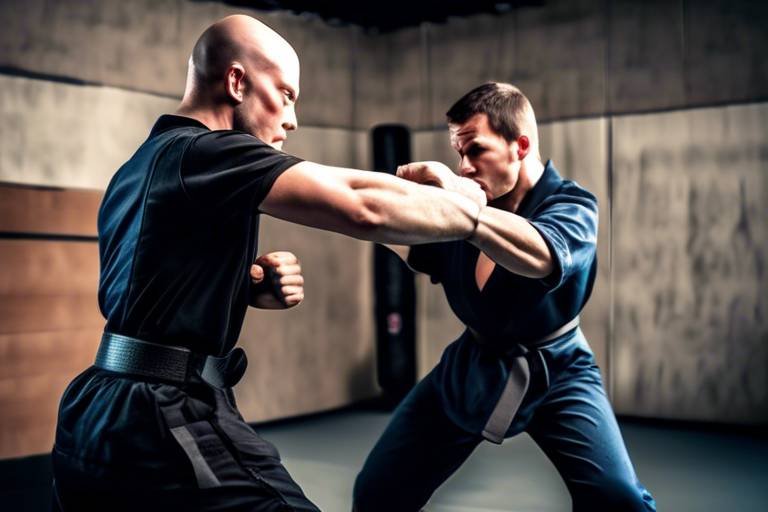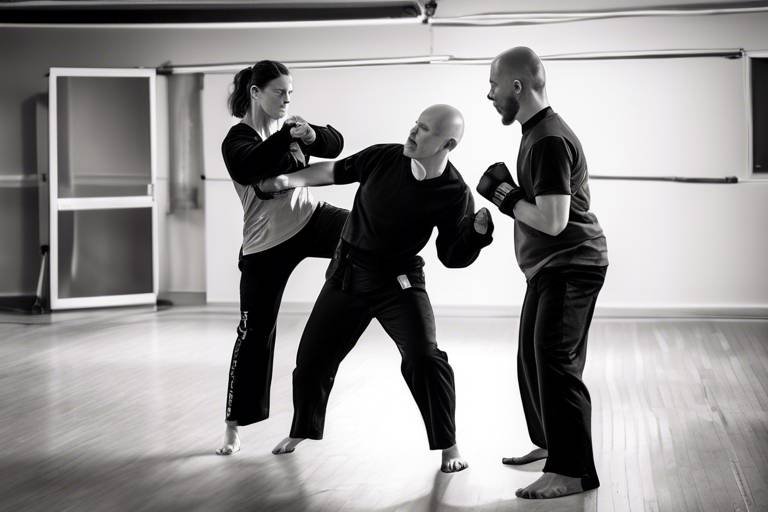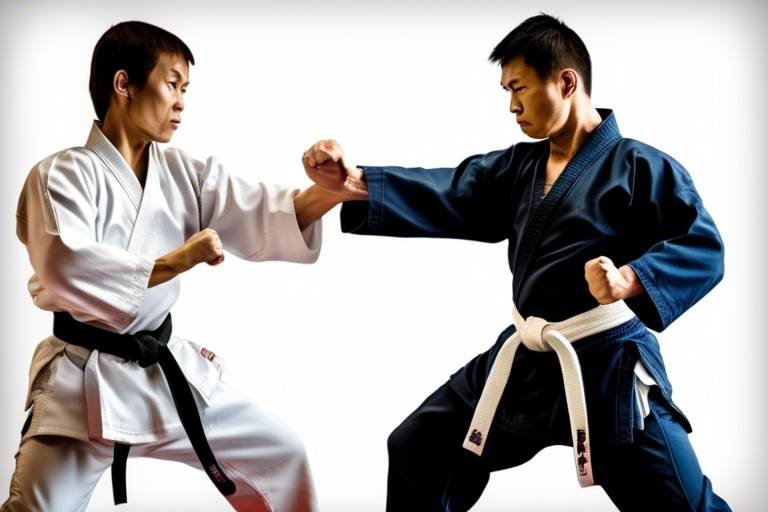Advantages of Solo Training in Mastering Self-Defense Techniques
When it comes to mastering self-defense techniques, one often overlooks the immense benefits of solo training. This approach not only allows individuals to hone their skills but also fosters a deeper understanding of their own abilities. Imagine being in a vast, empty dojo where the only sound is the echo of your movements. It’s just you and your practice, free from the distractions that often come with training in groups. This solitude can be a powerful catalyst for personal growth and skill enhancement.
In solo training, you have the unique advantage of enhanced focus and concentration. Without the chatter and movement of fellow practitioners, your mind can zero in on the techniques at hand. This undivided attention is crucial for mastering the intricacies of self-defense moves. You can experiment with different forms and styles, allowing your body to adapt and respond in ways that are instinctive. Think of it like tuning a musical instrument; the more you practice alone, the more finely tuned your skills become.
Another significant benefit of solo training is the personalized learning pace it offers. Each person has their own unique rhythm and style of learning. Some may grasp techniques quickly, while others may need more time to absorb the nuances. Training alone allows you to set your own pace, ensuring that you are not rushed or held back by others. This tailored approach can lead to a more profound understanding of self-defense principles, as you can spend as much time as you need on each technique without feeling pressured.
When you practice techniques repeatedly in a solo setting, you are not just going through the motions; you are actively building muscle memory. This process is akin to learning to ride a bike—the more you practice, the more natural it becomes. Over time, the movements required for effective self-defense will become second nature, allowing you to react instinctively in real-life situations. You won’t have to think about what to do; your body will know how to respond.
One of the greatest advantages of training alone is the chance for self-assessment. When you’re on your own, you can take the time to evaluate your strengths and weaknesses. Are you executing a particular technique correctly? Is there a specific move that feels awkward? By identifying areas for improvement, you can make the necessary adjustments to enhance your skills. This level of self-awareness is invaluable in the journey of mastering self-defense.
Additionally, solo practice encourages a spirit of experimentation. You can try out new techniques and combinations without the pressure of a partner watching or judging your movements. This freedom to explore can lead to surprising discoveries about your capabilities and preferences in self-defense. It’s like being an artist with a blank canvas; you have the creative liberty to paint your own unique style of self-defense.
As you become more familiar with your abilities through solo training, you will notice a significant boost in your confidence. This newfound self-assurance comes from knowing that you can rely on your skills in a crisis. The more you practice alone, the more independent you become in your self-defense capabilities. It’s empowering to realize that you are capable of protecting yourself, and this confidence extends beyond the training mat into everyday life.
Another compelling reason to consider solo training is the flexibility in your training schedule. Life can be hectic, with work, family, and social commitments often taking precedence. Training alone allows you to practice whenever it suits you best. Whether it’s early in the morning before the world wakes up or late at night when everyone else is asleep, you have the freedom to choose your training times. This consistency is key to developing and maintaining your skills over time.
In today’s digital age, there is an abundance of resources available to enhance your solo training experience. Online tutorials and instructional videos can provide valuable insights and techniques that you can incorporate into your practice. By leveraging these resources, you can broaden your understanding of self-defense and continually challenge yourself to learn more.
Lastly, training alone allows you to create a safe training environment. You can set up a space that feels comfortable and secure, reducing any anxiety that might come from practicing in a group. This comfort can lead to more focused practice sessions, where you can fully immerse yourself in the learning process without distractions. It’s like having your own personal sanctuary for self-improvement.
- What are the best techniques to practice during solo training? Focus on basic strikes, footwork, and defensive maneuvers that can be practiced without a partner.
- How often should I train alone? Consistency is key; aim for at least a few sessions each week to build and maintain your skills.
- Can I learn self-defense effectively without a partner? Absolutely! Solo training can be highly effective, especially when combined with online resources.

Enhanced Focus and Concentration
This article explores the benefits of solo training in self-defense, highlighting its effectiveness, flexibility, and personal growth opportunities for individuals seeking to enhance their skills and confidence in self-protection.
When it comes to mastering self-defense techniques, one of the most significant advantages of solo training is the it provides. Imagine being in a bustling dojo, surrounded by other practitioners, each moving through their routines while instructors shout corrections and encouragements. While this environment can be energizing, it can also be a source of distraction. In contrast, training alone allows you to create your own sanctuary of focus. You can concentrate solely on your movements, breathing, and the nuances of each technique without the noise and chaos that often accompany group settings.
With solo training, every session becomes an opportunity to dive deep into your practice. You can spend hours perfecting a single move, analyzing how your body responds to each shift in weight or angle. This level of concentration leads to a greater understanding of your body mechanics, ultimately resulting in improved performance. For instance, when you’re working on a kick, you can focus on:
- Alignment of your hips
- Foot placement
- Timing and rhythm
By honing in on these details, you develop a more profound mastery of your techniques that simply isn’t possible when your attention is divided.
Moreover, the ability to train in a distraction-free environment encourages a state of flow, where you become fully immersed in your practice. This mental state not only enhances your learning but also makes the experience more enjoyable. Think of it like cooking your favorite meal: when you’re alone in the kitchen, you can experiment with flavors and techniques, truly enjoying the process without interruptions. Similarly, solo training allows you to explore your self-defense practice in a way that feels both personal and rewarding.
Another benefit of solo training is the opportunity for mindfulness. Engaging in self-defense drills alone can serve as a form of meditation. As you repeat movements, you become more aware of your body and your surroundings. This heightened awareness can translate into real-life situations, where being mindful of your environment is crucial for self-defense. You learn to observe, anticipate, and react, which are essential skills not just in martial arts, but in everyday life.
In summary, training alone provides a unique platform for enhanced focus and concentration. It allows you to delve deeper into your techniques, improve your body mechanics, and cultivate a mindful approach to self-defense. This focused practice not only sharpens your skills but also builds a strong foundation of confidence that will serve you well in any situation. So, if you’re looking to elevate your self-defense game, consider embracing the power of solo training.
Solo training enables practitioners to learn at their own pace, allowing for a tailored approach that can accommodate different skill levels and learning styles.
Repeated practice of techniques in solo training helps develop muscle memory, making movements more instinctive and effective during real-life situations.
Training alone provides the chance for self-assessment, allowing individuals to identify strengths and weaknesses in their techniques and adjust accordingly.
Solo practice encourages experimentation, enabling practitioners to explore various techniques and combinations without the pressure of a partner.
Training alone builds self-confidence as individuals become more familiar with their abilities and develop a sense of independence in their self-defense skills.
Solo training offers the flexibility to practice whenever convenient, accommodating busy lifestyles and ensuring consistent skill development.
Individuals can use various resources, such as online tutorials and instructional videos, to enhance their solo training experience and broaden their understanding of self-defense techniques.
Training alone allows individuals to create a comfortable and safe environment, reducing anxiety and enabling a more focused practice session.
- Can solo training be as effective as training with a partner? Absolutely! Solo training allows for intense focus and personalized skill development.
- How can I stay motivated during solo training? Set clear goals, track your progress, and vary your routines to keep things fresh and exciting.
- What resources are best for solo training? Online tutorials, instructional videos, and self-defense books are excellent resources to enhance your learning experience.

Personalized Learning Pace
When it comes to mastering self-defense techniques, one of the most significant advantages of solo training is the ability to embrace a . This means you get to dictate the rhythm of your training sessions, allowing for a tailored approach that aligns with your unique skill level and learning style. Think of it like cooking your favorite dish; you can adjust the ingredients to suit your taste, ensuring that the final product is just right for you. Whether you're a beginner trying to grasp the basics or an experienced practitioner looking to refine advanced techniques, training alone allows you to carve your own path.
Imagine being able to spend extra time on a technique that feels tricky or moving swiftly through a drill that you’ve already mastered. This freedom not only enhances your learning experience but also fosters a deeper connection with the material. You can take the time to understand the nuances of each movement, practicing until it feels second nature. For instance, if you find a particular self-defense maneuver challenging, solo training allows you to repeat it as many times as necessary until you feel confident. This is something that can be harder to achieve in a group setting where the pace is dictated by the instructor or the group dynamics.
Moreover, personalized pacing can significantly reduce the pressure often felt in a class environment. When training with others, the tendency to compare yourself to peers can be overwhelming. Solo practice eliminates this distraction, allowing you to focus solely on your progress. You can set realistic goals for yourself, whether that means perfecting a kick, enhancing your footwork, or building your overall stamina. By setting specific milestones, you can monitor your progress and celebrate small victories along the way, which is crucial for maintaining motivation.
In addition, this individualized approach encourages a sense of accountability. When you're the only one responsible for your learning, it becomes essential to stay committed. You might find that you develop a stronger work ethic, pushing yourself to practice regularly and challenge your limits. And if you ever feel stuck, the beauty of solo training is that you can seek out resources at your own convenience. Online tutorials, instructional videos, and self-defense blogs are all at your fingertips, ready to provide new insights and techniques tailored to your learning needs.
The ability to learn at your own pace is not just about speed; it’s also about depth. You can explore various self-defense styles, experiment with different techniques, and truly immerse yourself in the art of self-defense. This exploration can lead to a more profound understanding of how techniques work in real-life scenarios, as you take the time to analyze and adapt them to your own body and strengths. So, whether you’re looking to build confidence, enhance your skills, or simply enjoy the journey of learning, the personalized learning pace offered by solo training is a game-changer.
- Can I learn self-defense effectively by training alone? Yes! Solo training allows for focused practice and personalized pacing, which can lead to effective learning.
- What resources can I use for solo training? There are many online tutorials, instructional videos, and self-defense blogs that can enhance your learning experience.
- How can I stay motivated while training alone? Setting realistic goals and tracking your progress can help maintain motivation during solo practice.

Building Muscle Memory
When it comes to mastering self-defense techniques, one of the most crucial elements is . This is the process by which your body learns to perform specific movements automatically, without the need for conscious thought. Think of it like riding a bike; once you’ve learned how to balance and pedal, you can do it effortlessly, even years later. Solo training is an incredible way to develop this muscle memory, as it allows for repeated practice of techniques in a focused environment.
During solo training sessions, you can dedicate time to practicing specific moves over and over again. This repetition is key to embedding these actions into your muscle memory. For instance, when practicing a particular self-defense maneuver, such as a block or a counterattack, the more you perform the movement, the more natural it becomes. You might find that your body starts to react instinctively to certain situations, which is exactly what you want in a self-defense scenario.
Moreover, the beauty of solo training is that you can tailor your practice to focus on areas where you might need improvement. If you struggle with a particular technique, you can spend extra time perfecting it without the pressure of a partner watching or needing to coordinate with someone else. This personalized approach not only enhances your skills but also boosts your confidence as you see tangible improvements over time.
To illustrate how muscle memory works in self-defense, consider the following table that outlines the key components involved:
| Component | Description |
|---|---|
| Repetition | The act of practicing a movement multiple times to reinforce it in your memory. |
| Focus | Concentrating on the technique being practiced to ensure proper form and execution. |
| Feedback | Self-assessing your performance to identify areas for improvement. |
| Consistency | Regular practice over time to maintain and enhance muscle memory. |
As you engage in solo training, remember to pay attention to your body’s movements. Are you executing techniques correctly? Are there adjustments you need to make? This self-assessment is vital. It allows you to refine your skills continuously, ensuring that when the moment arises where you need to defend yourself, your body responds with the right action without hesitation.
In conclusion, building muscle memory through solo training is an invaluable part of mastering self-defense techniques. The more you practice, the more instinctive your responses will become. So, grab your training gear, find a comfortable space, and start honing those skills. Your future self will thank you for it!
- How long does it take to build muscle memory? Muscle memory can develop over weeks to months, depending on the frequency and quality of practice.
- Can I build muscle memory without a partner? Absolutely! Solo training is highly effective for developing muscle memory.
- What techniques are best for solo practice? Focus on basic movements such as punches, kicks, blocks, and footwork to start with.
- How often should I practice to build muscle memory? Aim for at least 3-4 times a week for optimal results.

Self-Assessment Opportunities
This article explores the benefits of solo training in self-defense, highlighting its effectiveness, flexibility, and personal growth opportunities for individuals seeking to enhance their skills and confidence in self-protection.
Training alone allows individuals to focus entirely on their techniques without distractions, leading to improved concentration and mastery of self-defense moves.
Solo training enables practitioners to learn at their own pace, allowing for a tailored approach that can accommodate different skill levels and learning styles.
Repeated practice of techniques in solo training helps develop muscle memory, making movements more instinctive and effective during real-life situations.
One of the most significant benefits of solo training is the opportunity for self-assessment. When you're practicing alone, you have the unique chance to evaluate your performance critically. This means you can take a step back and really analyze how you're executing each technique. Are you using the correct form? Is your timing on point? By regularly assessing your skills, you can identify both your strengths and weaknesses.
For instance, if you notice that a particular move feels awkward, you can dedicate more time to refining it without the pressure of a partner watching or waiting. This freedom allows for a deeper understanding of your capabilities and limitations. You might even consider keeping a training journal, where you can jot down your observations and track your progress over time. This kind of reflective practice can be incredibly rewarding and motivating.
Moreover, self-assessment can also lead to the development of personalized training goals. By understanding where you excel and where you need improvement, you can set specific, measurable objectives. For example:
- Improving your striking speed
- Enhancing your footwork
- Mastering a specific technique
Each of these goals can then be broken down into actionable steps that you can work on during your solo sessions. This structured approach not only keeps you focused but also makes your training more effective.
In summary, the self-assessment opportunities that solo training provides are invaluable. They empower you to take control of your learning journey, ensuring that you are not just going through the motions but truly mastering the art of self-defense.
Solo training offers the flexibility to practice whenever convenient, accommodating busy lifestyles and ensuring consistent skill development.
Individuals can use various resources, such as online tutorials and instructional videos, to enhance their solo training experience and broaden their understanding of self-defense techniques.
Training alone allows individuals to create a comfortable and safe environment, reducing anxiety and enabling a more focused practice session.
Q: Can I really learn self-defense effectively by training alone?
A: Absolutely! Solo training can be incredibly effective, especially when combined with proper self-assessment and the use of resources.
Q: How often should I practice solo?
A: It depends on your schedule, but consistency is key. Aim for at least a few sessions each week to maintain and improve your skills.
Q: What resources can I use for solo training?
A: There are many online tutorials, instructional videos, and even apps designed specifically for self-defense training that can enhance your practice.

Experimentation with Techniques
This article explores the benefits of solo training in self-defense, highlighting its effectiveness, flexibility, and personal growth opportunities for individuals seeking to enhance their skills and confidence in self-protection.
Training alone allows individuals to focus entirely on their techniques without distractions, leading to improved concentration and mastery of self-defense moves.
Solo training enables practitioners to learn at their own pace, allowing for a tailored approach that can accommodate different skill levels and learning styles.
Repeated practice of techniques in solo training helps develop muscle memory, making movements more instinctive and effective during real-life situations.
Training alone provides the chance for self-assessment, allowing individuals to identify strengths and weaknesses in their techniques and adjust accordingly.
One of the most exhilarating aspects of solo training is the ability to experiment with various self-defense techniques. Imagine being a chef in a kitchen, free to mix ingredients without the fear of judgment; that’s the kind of liberating experience solo training offers. You can try out different moves, combinations, and strategies at your own pace, without the pressure of a partner waiting for you to execute perfectly. This freedom encourages creativity and innovation in your training regimen.
When practicing alone, you can explore:
- Different Techniques: Whether you're interested in striking, grappling, or evasive maneuvers, you can dedicate time to each technique, understanding its nuances without rushing.
- Combining Techniques: You can experiment with blending techniques from various martial arts, discovering unique combinations that suit your style.
- Adapting Movements: Solo training allows you to modify techniques to see what feels most natural for your body type and physical abilities.
This experimentation not only enhances your understanding of self-defense but also boosts your adaptability in real-world situations. By trying out different approaches, you become more versatile, enabling you to respond effectively when facing unexpected challenges. Moreover, the process can be incredibly empowering; witnessing your own growth and discovering what works best for you can ignite a passion for continuous improvement.
Training alone builds self-confidence as individuals become more familiar with their abilities and develop a sense of independence in their self-defense skills.
Solo training offers the flexibility to practice whenever convenient, accommodating busy lifestyles and ensuring consistent skill development.
Individuals can use various resources, such as online tutorials and instructional videos, to enhance their solo training experience and broaden their understanding of self-defense techniques.
Training alone allows individuals to create a comfortable and safe environment, reducing anxiety and enabling a more focused practice session.
Absolutely! Solo training can be incredibly effective. It allows you to focus on your techniques and learn at your own pace, which can lead to significant improvements.
Setting personal goals, tracking your progress, and varying your training routine can help keep you motivated. Additionally, joining online communities can provide support and encouragement.
Online tutorials, instructional videos, and self-defense books are great resources. You can also consider apps that offer guided workouts and techniques.
Yes, as long as you practice in a safe environment and be mindful of your surroundings. Always prioritize safety and ensure that you are in a space where you can train without risk of injury.

Increased Confidence
When it comes to mastering self-defense techniques, one of the most significant benefits of solo training is the boost in confidence that practitioners experience. Imagine standing in front of a mirror, practicing your moves, and feeling the adrenaline rush as your body becomes more familiar with each technique. This personal journey of self-discovery allows individuals to become intimately acquainted with their own capabilities. As you repeatedly practice, you start transforming from a hesitant beginner into a self-assured fighter, ready to tackle any challenge that may come your way.
As you engage in solo training, you’re not just learning how to defend yourself; you’re also building a strong mental framework. This newfound confidence can spill over into other areas of life, enhancing your overall self-esteem. Think of it as a ripple effect: as you become more competent in self-defense, you may find yourself more assertive in social situations or even at work. You might be surprised at how this confidence can change your interactions with others, making you feel more empowered and in control.
Moreover, training alone allows you to set your own goals and measure your progress. Each time you master a new technique or improve your form, it serves as a personal victory. This sense of achievement is crucial for building confidence. You might even consider maintaining a training journal where you can document your progress, reflect on your experiences, and celebrate your milestones. This practice not only reinforces your learning but also acts as a motivational tool, reminding you of how far you’ve come.
In addition, solo training provides an opportunity for self-reflection. Without the distractions of a partner or group setting, you can focus on your thoughts and feelings about your training. You might ask yourself questions like:
- What techniques do I feel most comfortable with?
- Which areas do I need to improve on?
- How do I feel after each training session?
Answering these questions can help you identify not only your strengths but also the areas that require more attention. This self-awareness is crucial for personal growth and can significantly enhance your confidence levels.
In summary, the journey of solo training in self-defense is not just about physical skills; it’s about cultivating a strong sense of self. As you practice, you’ll find that your confidence grows, empowering you to face life’s challenges head-on. So, if you’re considering diving into solo training, remember: with each punch, kick, and block, you’re not just learning how to defend yourself—you’re also building a more confident version of yourself.
- How long should I train alone to see improvements?
The amount of time varies, but consistent practice—ideally several times a week—will lead to noticeable improvements over a few months. - Can I really learn self-defense effectively without a partner?
Absolutely! Solo training can be highly effective, especially when combined with online resources and instructional videos. - What if I feel stuck in my training?
Consider mixing up your routine, trying new techniques, or seeking online tutorials to reignite your motivation.

Flexibility in Training Schedule
This article explores the benefits of solo training in self-defense, highlighting its effectiveness, flexibility, and personal growth opportunities for individuals seeking to enhance their skills and confidence in self-protection.
Training alone allows individuals to focus entirely on their techniques without distractions, leading to improved concentration and mastery of self-defense moves.
Solo training enables practitioners to learn at their own pace, allowing for a tailored approach that can accommodate different skill levels and learning styles.
Repeated practice of techniques in solo training helps develop muscle memory, making movements more instinctive and effective during real-life situations.
Training alone provides the chance for self-assessment, allowing individuals to identify strengths and weaknesses in their techniques and adjust accordingly.
Solo practice encourages experimentation, enabling practitioners to explore various techniques and combinations without the pressure of a partner.
Training alone builds self-confidence as individuals become more familiar with their abilities and develop a sense of independence in their self-defense skills.
One of the most significant advantages of solo training is the flexibility it offers in scheduling. Unlike traditional classes that require you to be present at specific times, solo training allows you to practice whenever it suits you best. Whether you're an early bird who loves to train at dawn or a night owl who prefers to hit the mat after a long day, the choice is entirely yours. This flexibility not only accommodates busy lifestyles but also ensures that you can consistently work on your skills without feeling pressured by external commitments.
Imagine this: you have a busy week ahead, filled with work meetings and social obligations. With solo training, you can easily carve out time during your lunch break or even squeeze in a session during a quiet moment at home. This adaptability can be a game-changer in maintaining a regular training routine. Moreover, the ability to choose your training times means you can also align your sessions with your peak energy levels, making your practice more effective.
Additionally, you can create a personalized training schedule that suits your specific goals. Are you looking to improve your striking techniques one day and focus on grappling the next? With solo training, you have the freedom to structure your sessions as you see fit. You can even set short-term goals and adjust your training plan accordingly. For instance, if you find a particular technique challenging, you can dedicate more time to it without having to coordinate with a partner's availability.
To further illustrate the benefits of flexibility in training schedules, consider the following table:
| Training Time | Advantages |
|---|---|
| Morning | High energy, sets a positive tone for the day |
| Lunch Break | Quick refresh, reduces stress, and boosts productivity |
| Evening | Wind down after a long day, allows for longer sessions |
| Weekends | More time for extended practice and experimentation |
In summary, the flexibility in training schedules that solo practice provides not only enhances your ability to train regularly but also empowers you to take control of your learning journey. You can adapt your training to your life, making self-defense practice a seamless part of your routine rather than an obligation. This adaptability is key to staying motivated and engaged in your self-defense training.
- Can I really learn self-defense effectively by training alone? Absolutely! Solo training allows you to focus on your techniques and practice at your own pace.
- What resources can I use for solo training? You can utilize online tutorials, instructional videos, and even books to enhance your learning experience.
- How do I stay motivated when training alone? Setting personal goals, tracking your progress, and varying your training routine can help maintain motivation.
- Is solo training suitable for beginners? Yes, solo training is perfect for beginners as it allows for personalized learning and self-assessment.

Utilizing Available Resources
In today's digital age, the wealth of resources available for self-defense training is nothing short of astounding. Whether you’re a beginner just dipping your toes into the world of self-defense or a seasoned practitioner looking to refine your skills, these resources can be invaluable. Imagine having a personal coach available at your fingertips, ready to guide you through every technique and movement—this is what online resources offer! From video tutorials to interactive forums, the options are endless.
One of the most effective ways to enhance your solo training is by utilizing online platforms. Websites like YouTube are treasure troves of instructional videos, where experienced martial artists share their insights and techniques. You can find everything from basic stances to advanced maneuvers, all of which can be practiced in the comfort of your own home. Moreover, many of these videos are free, making them accessible to anyone, regardless of budget.
Additionally, consider enrolling in online courses offered by reputable self-defense instructors. These courses often provide structured learning paths that can help you build your skills progressively. Many platforms also offer downloadable content, allowing you to revisit lessons and practice at your own pace. The beauty of this approach is that it caters to your unique learning style—whether you prefer visual demonstrations, written instructions, or a combination of both, there’s something out there for you.
Another fantastic resource is social media. Platforms like Instagram and TikTok are filled with self-defense enthusiasts sharing quick tips and techniques. Following these accounts can provide you with daily motivation and inspiration, keeping your training fresh and exciting. Plus, engaging with these communities can lead to valuable discussions, where you can ask questions and share your experiences with others who share your passion.
Lastly, don't underestimate the power of books and e-books. There are countless publications dedicated to self-defense techniques, philosophy, and psychology. Reading about self-defense not only enhances your understanding of the subject but also helps you visualize and mentally prepare for various scenarios. Here’s a quick table summarizing some popular resources:
| Resource Type | Examples | Benefits |
|---|---|---|
| Video Tutorials | YouTube, Vimeo | Visual learning, diverse techniques |
| Online Courses | Udemy, Skillshare | Structured learning, expert guidance |
| Social Media | Instagram, TikTok | Community engagement, quick tips |
| Books/E-books | Amazon, local bookstores | In-depth knowledge, visualization |
By leveraging these resources, you can create a well-rounded training regimen that not only enhances your skills but also keeps you motivated and engaged. The key is to remain curious and open to learning—after all, self-defense is not just about physical techniques; it's also about understanding the mindset that comes with it. So, dive into these resources, experiment with different techniques, and watch as your confidence and abilities soar!
Q: Can I learn self-defense effectively through online resources alone?
A: Yes, many individuals successfully learn self-defense through online tutorials and courses. However, complementing online training with practical experience, whenever possible, is recommended for the best results.
Q: How often should I practice solo to see improvement?
A: Consistency is key! Aim to practice at least a few times a week, even if it's just for 15-30 minutes. Regular practice helps reinforce muscle memory and technique.
Q: Are there any specific online platforms you recommend?
A: Platforms like YouTube for free tutorials, Udemy for structured courses, and social media for community engagement are all great starting points.

Creating a Safe Training Environment
This article explores the benefits of solo training in self-defense, highlighting its effectiveness, flexibility, and personal growth opportunities for individuals seeking to enhance their skills and confidence in self-protection.
Training alone allows individuals to focus entirely on their techniques without distractions, leading to improved concentration and mastery of self-defense moves.
Solo training enables practitioners to learn at their own pace, allowing for a tailored approach that can accommodate different skill levels and learning styles.
Repeated practice of techniques in solo training helps develop muscle memory, making movements more instinctive and effective during real-life situations.
Training alone provides the chance for self-assessment, allowing individuals to identify strengths and weaknesses in their techniques and adjust accordingly.
Solo practice encourages experimentation, enabling practitioners to explore various techniques and combinations without the pressure of a partner.
Training alone builds self-confidence as individuals become more familiar with their abilities and develop a sense of independence in their self-defense skills.
Solo training offers the flexibility to practice whenever convenient, accommodating busy lifestyles and ensuring consistent skill development.
Individuals can use various resources, such as online tutorials and instructional videos, to enhance their solo training experience and broaden their understanding of self-defense techniques.
One of the most significant advantages of solo training is the ability to create a safe training environment. When you're practicing alone, you have complete control over your surroundings, which can greatly enhance your focus and comfort level. Imagine stepping onto a mat or a training space where you feel completely at ease—no distractions, no pressure from a partner, just you and your techniques. This freedom allows you to concentrate fully on your movements and improve your skills without the fear of judgment or injury.
Moreover, a safe environment allows you to practice at your own pace. You can experiment with different techniques and combinations, adjusting your movements as needed without worrying about a partner's reaction. This aspect is particularly beneficial for beginners who might feel intimidated in a group setting. You can take your time to understand each technique, ensuring that you are performing it correctly before moving on to the next.
To further enhance this safe training environment, consider the following:
- Choose a spacious area: Make sure your training space is free from obstacles to prevent injuries.
- Use proper gear: Wearing appropriate protective gear can give you peace of mind as you practice.
- Set a positive mindset: Approach each training session with a focus on growth and self-improvement.
By creating a safe space, you not only enhance your physical practice but also cultivate a mental environment that encourages learning and growth. This dual focus on both the physical and mental aspects of training can lead to remarkable improvements in your self-defense skills.
Q1: Can I really learn self-defense effectively by training alone?
A1: Yes! Solo training allows you to focus on your techniques and build muscle memory without distractions. Many self-defense practitioners find great success through independent practice.
Q2: How do I ensure I'm practicing techniques correctly when training alone?
A2: Utilize online tutorials, instructional videos, and self-assessment techniques to ensure you're practicing correctly. Recording your sessions can also help you identify areas for improvement.
Q3: Is it safe to practice self-defense techniques alone?
A3: Practicing in a safe and controlled environment can minimize risks. Always be mindful of your surroundings and use appropriate protective gear when necessary.
Q4: What if I have questions or need guidance while training alone?
A4: Consider joining online forums or communities where you can ask questions and share experiences with others. Many self-defense instructors also offer virtual classes or consultations.
Frequently Asked Questions
- What are the main benefits of solo training for self-defense?
Solo training offers a variety of benefits, including enhanced focus and concentration, personalized learning pace, and the opportunity to build muscle memory. It allows individuals to practice techniques without distractions, helping them master self-defense moves more effectively.
- Can I really learn self-defense techniques effectively on my own?
Absolutely! Many individuals find that training alone allows them to learn at their own pace and tailor their practice to their specific needs. With consistent effort and the right resources, solo training can be just as effective as training with a partner.
- How can I assess my progress while training solo?
Self-assessment is a key component of solo training. By regularly reviewing your techniques and identifying areas for improvement, you can track your progress. Recording your sessions or using mirrors can also help you evaluate your movements and refine your skills.
- Is it safe to practice self-defense techniques alone?
Yes, practicing alone can be safe, especially when you create a comfortable training environment. Ensure that you have enough space to move freely and avoid practicing techniques that require a partner until you're confident in your abilities.
- What resources can I use to enhance my solo training?
There are plenty of resources available to support your solo training. Online tutorials, instructional videos, and self-defense apps can provide valuable guidance. Additionally, books and articles on self-defense techniques can broaden your understanding and help you practice effectively.
- How does solo training help build confidence?
Training alone allows individuals to become more familiar with their abilities, which naturally boosts confidence. As you practice and improve your skills independently, you develop a sense of self-reliance that translates into greater confidence in real-life situations.
- Can I experiment with techniques during solo training?
Definitely! One of the great advantages of solo training is the freedom to experiment with different techniques and combinations without the pressure of a partner. This exploration can lead to discovering what works best for you and enhancing your overall skill set.
- How flexible is the training schedule for solo practice?
Solo training is incredibly flexible! You can practice whenever it fits into your schedule, whether that's early in the morning, during lunch breaks, or late at night. This flexibility allows you to maintain consistent training, even with a busy lifestyle.





